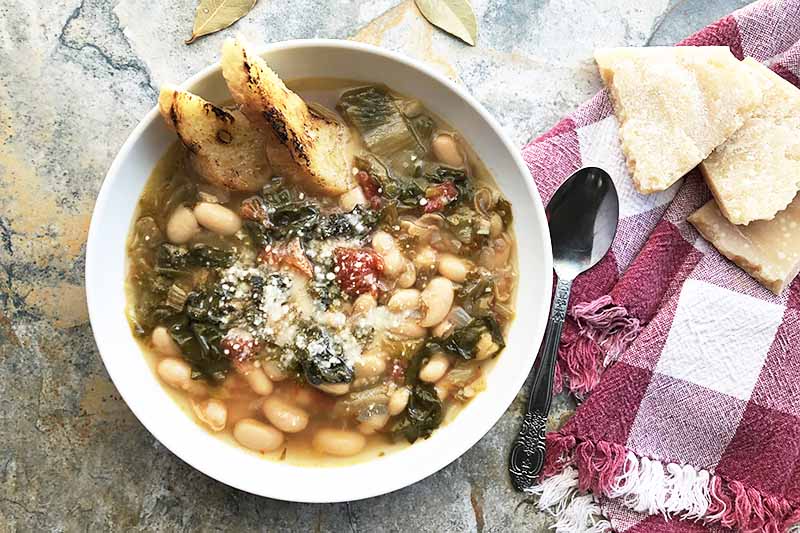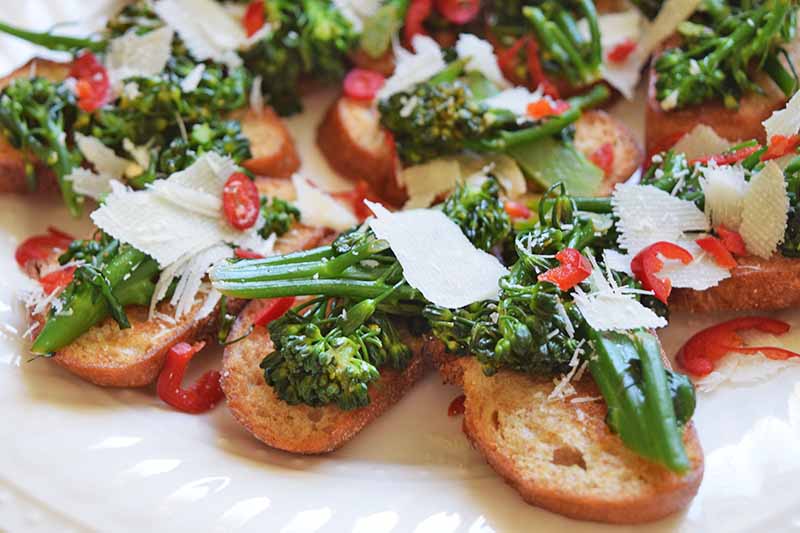You can use floating row covers to protect your crop – and check out our guide to controlling cabbage loopers for more ideas.
Flea Beetles
Flea beetles also enjoy feasting on rapini leaves. They are most recognizable by the damage they do – leaving tiny, round “shot holes” in the foliage.
Before you kill any other tiny garden beetles thinking they are flea beetles, however, make sure you have correctly identified them – there are some beneficial insects, such as spider mite destroyers, which can be mistaken for these pests.
Flea beetles don’t usually do enough damage to harm broccoli raab, In my own garden, I ignore the minimal damage caused by these pests.
Instead I focus on attracting natural flea beetle enemies such as braconid wasps, which love the umbel-shaped flowers of cilantro, dill, and yarrow.
You can learn more about managing flea beetles here.
Leaf Miners
Leaf miners leave distinctive maze-like marks in the foliage.
These pests are actually flies, but it isn’t the adults that create the damage, it is the larvae feeding as they burrow through the leaf tissue.

In addition to aesthetic damage, these burrows can interfere with photosynthesis.
As with flea beetles, parasitic wasps are important in keeping leaf miner populations down.
To encourage parasitic wasps, grow plants they like nearby. In addition to cilantro and dill, cosmos is another beneficial wasp favorite.
Remove any damaged foliage and give your plants a chance to recover before resorting to pesticides, which are harmful to beneficial insects.
Disease
There are a few common diseases that can affect your crop, but they are not very common if plants are grown in optimal conditions.
Alternaria Leaf Spot
Alternaria leaf spot is a fungal disease that causes brown lesions on the foliage with white or gray centers. These lesions are often surrounded by yellow halos.
The fungi that cause this disease flourish in hot, humid conditions.


To prevent infection, provide adequate spacing between plants and encourage good air circulation.
Also, rather than watering your crop with a sprinkler, water close to the surface of the soil instead.
Treatment of this disease is much the same in rapini as it is in its close relative, the turnip.
To learn more, read our article on identifying and treating Alternaria leaf spot on turnips.
Damping Off
Damping off is caused by a soilborne pathogen that causes young seedlings to suddenly wither and die.
Cool, wet conditions and poorly draining soil put seedlings at risk for this disease. As a preventive measure, make sure the soil is well-draining, and don’t overwater.
To learn more about preventing this disease, read our article about damping off.
Downy Mildew
Downy mildew is a disease caused by fungus-like organisms called water molds (oomycetes). It is a risk when the weather is cool and humid.
Affected plants have yellow lesions on the surface of the leaves and white or gray fungus-like growth on the undersides.
Lesions eventually turn brown and the entire leaf can become papery before falling off the plant.
To prevent this disease, water at the soil level with a watering wand or via drip irrigation rather than with an overhead sprinkler.
To learn more, read our article about treating downy mildew and other cabbage family diseases.
Harvesting
Your crop should be ready for its first harvest about six to eight weeks after sowing, depending on your selected variety.
However, rather than sticking strictly to the calendar, keep an eye on the buds and make you harvest before they open.


If possible, plan to harvest for the morning, when the foliage will be at its freshest.
A pair of scissors or garden snips will be helpful here – just make sure they are clean, to reduce the risk of spreading diseases.
Cut most of the vegetation back for your harvest, leaving the plant just a few inches tall.
For continued harvests, make sure to leave a few leaves on each plant, to encourage regrowth.
Plan to pick more every time the buds are ready. Some gardeners can achieve three harvests from each plant.
Preserving
Like other leafy greens, these are best when eaten fresh from the garden.
It will keep in the fridge for up to a week, but for the best flavor, try to use broccoli rabe when it’s fresh!


To freeze your harvest, blanch it first. Place the greens in boiling water for two minutes, then dip them in an icy water bath to quickly cool.
Drain, then place in freezer-proof containers and store in the freezer, where it will keep for up to 12 months.
Rapini can also be preserved in jars, much like other greens such as spinach. Since this vegetable is low in acid it will need to be pressure canned.
To learn more, find tips on pressure canning at our sister site, Foodal.
Cooking Ideas
In addition to being used in Italian and Chinese cuisine, this green is a staple in traditional Spanish and Galician cuisine as well, such as in the soup caldo Gallego.
Rapini can be cooked like any other leafy green – steamed, sauteed, added to an omelet or quiche, mixed with pasta, or used as a pizza topping.
The pungent flavors marry particularly well with hot peppers, ginger, or garlic.


Raab also combines well with beans, such as in this recipe for cheap and easy Italian style beans and greens soup, from our sister site, Foodal.


For a light meal or appetizer, you can also use it as a topping for toast, such as in this recipe for tartines topped with broccoli rabe, chilies, and pecorino. Find it on Foodal.
The Best Bitter Buds
You now have all of the information you need to sow, grow, harvest, and even cook up a delicious batch of homegrown broccoli rabe. So, what are you waiting for?


Are you a fan of these pungent greens? Tell us about your gardening or cooking experiences with rapini – and let us know what you call it – in the comments section below.
If you are growing other cruciferous vegetables along with your rapini, you might want to review these growing guides as well:


